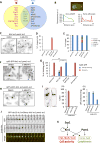Mechanisms Connecting the Conserved Protein Kinases Ssp1, Kin1, and Pom1 in Fission Yeast Cell Polarity and Division
- PMID: 29249658
- PMCID: PMC5760279
- DOI: 10.1016/j.cub.2017.11.034
Mechanisms Connecting the Conserved Protein Kinases Ssp1, Kin1, and Pom1 in Fission Yeast Cell Polarity and Division
Abstract
Connections between the protein kinases that function within complex cell polarity networks are poorly understood. Rod-shaped fission yeast cells grow in a highly polarized manner, and genetic screens have identified many protein kinases, including the CaMKK-like Ssp1 and the MARK/PAR-1 family kinase Kin1, that are required for polarized growth and cell shape, but their functional mechanisms and connections have been unknown [1-5]. We found that Ssp1 promotes cell polarity by phosphorylating the activation loop of Kin1. Kin1 regulates cell polarity and cytokinesis through unknown mechanisms [4-7]. We performed a large-scale phosphoproteomic screen and found that Kin1 phosphorylates itself and Pal1 to promote growth at cell tips, and these proteins are interdependent for localization to growing cell tips. Additional Kin1 substrates for cell polarity and cytokinesis (Tea4, Mod5, Cdc15, and Cyk3) were also phosphorylated by a second kinase, the DYRK family member Pom1 [8]. Kin1 and Pom1 were enriched at opposite ends of growing cells, and they phosphorylated largely non-overlapping sites on shared substrates. Combined inhibition of both Kin1and Pom1 led to synthetic defects in their shared substrates Cdc15 and Cyk3, confirming a non-redundant functional connection through shared substrates. These findings uncover a new Ssp1-Kin1 signaling pathway, and define its functional and mechanistic connection with Pom1 signaling for cell polarity and cytokinesis. These kinases are conserved in many eukaryotes including humans, suggesting that similar connections and mechanisms might operate in a broad range of cells.
Keywords: Kin1; Pom1; Ssp1; cytokinesis; kinase; polarity; pombe; yeast.
Copyright © 2017 Elsevier Ltd. All rights reserved.
Figures




References
-
- Koyano T, Kume K, Konishi M, Toda T, Hirata D. Search for kinases related to transition of growth polarity in fission yeast. Bioscience, biotechnology, and biochemistry. 2010;74:1129–1133. - PubMed
-
- Drewes G, Nurse P. The protein kinase kin1, the fission yeast orthologue of mammalian MARK/PAR-1, localises to new cell ends after mitosis and is important for bipolar growth. FEBS letters. 2003;554:45–49. - PubMed
Publication types
MeSH terms
Substances
Grants and funding
LinkOut - more resources
Full Text Sources
Other Literature Sources
Molecular Biology Databases

